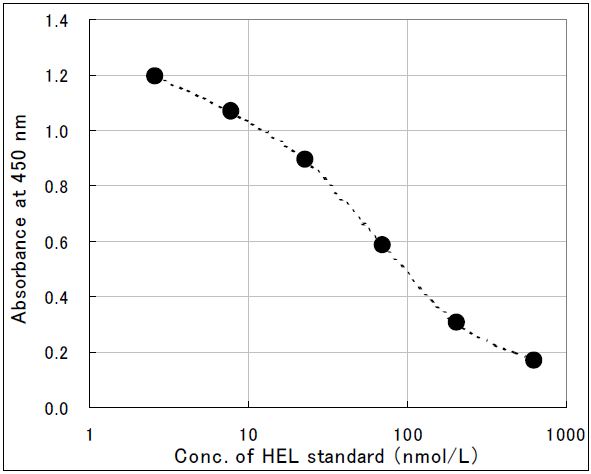
Standard Curve
Hexanoyl-Lys [HEL] ELISA Kit
JAI-KHL-700E
ReactivityAll Species, Human
Product group Assays
Overview
- SupplierJaICA
- Product NameHexanoyl-Lys [HEL] ELISA Kit
- Delivery Days Customer10
- ApplicationsELISA
- Assay Detection Range2 - 700 nmol/L
- CertificationResearch Use Only
- Scientific DescriptionKit. Specific to N-epsilon-Hexanoyl-Lysine adduct. Range: 2 - 700 nmol/L. Oxidative damage to lipids (lipid peroxidation) has been found to play an important role in various disease and aging processes. During early stages of lipid peroxidation, lipid hydroperoxides (LOOH) are formed. These can react additionally to form later stage end products such as malondialdehyde (MDA) and hydroxynonenal (HNE). LOOH is measured to quantify early stage or acute lipid peroxidation while MDA is commonly measured to quantify late stage or chronic lipid peroxidation. More recently, it has been reported that 13-hydroperoxyoctadecanoic acid (13-HPODE), a precursor to 13-hydroxyoctadecanoic acid (13-HODE) can react with proteins to form measurable adducts by covalently binding to specific amino acid residues. The Hexanoyl-Lysine (HEL) adduct is formed upon oxidative modification of omega-6 fatty acids such as linoleic acid, the predominant polyunsaturated fatty acid (PUFA) in the human diet, and arachidonic acid. HEL may be another useful biomarker for detecting and quantifying the earlier stages of lipid peroxidation. This ELISA Kits works also for DNA extracted from cultured cells or tissues. - Oxidative damage to lipids (lipid peroxidation) has been found to play an important role in various disease and aging processes. During early stages of lipid peroxidation, lipid hydroperoxides (LOOH) are formed. These can react additionally to form later stage end products such as malondialdehyde (MDA) and hydroxynonenal (HNE). LOOH is measured to quantify early stage or acute lipid peroxidation while MDA is commonly measured to quantify late stage or chronic lipid peroxidation. More recently, it has been reported that 13-hydroperoxyoctadecanoic acid (13-HPODE), a precursor to 13-hydroxyoctadecanoic acid (13-HODE) can react with proteins to form measurable adducts by covalently binding to specific amino acid residues. The Hexanoyl-Lysine (HEL) adduct is formed upon oxidative modification of omega-6 fatty acids such as linoleic acid, the predominant polyunsaturated fatty acid (PUFA) in the human diet, and arachidonic acid. HEL may be another useful biomarker for detecting and quantifying the earlier stages of lipid peroxidation.
- ReactivityAll Species, Human
- Storage Instruction2°C to 8°C
- UNSPSC41116158
